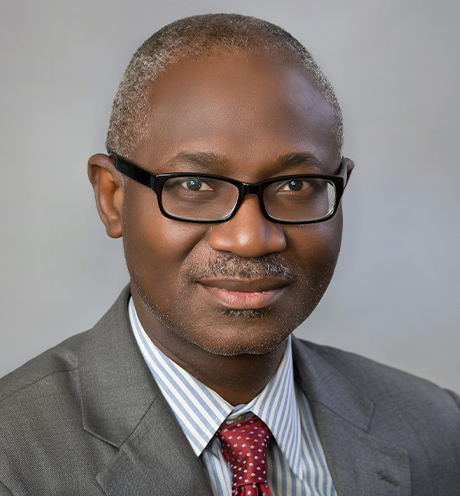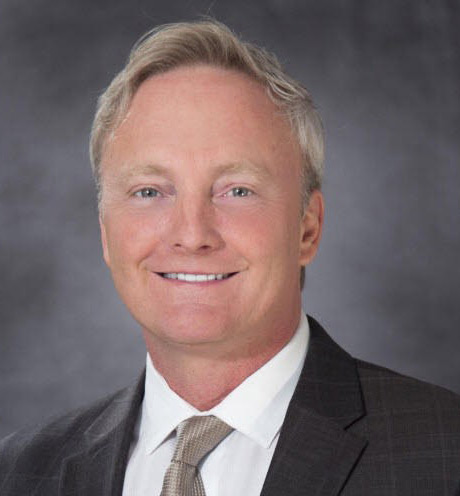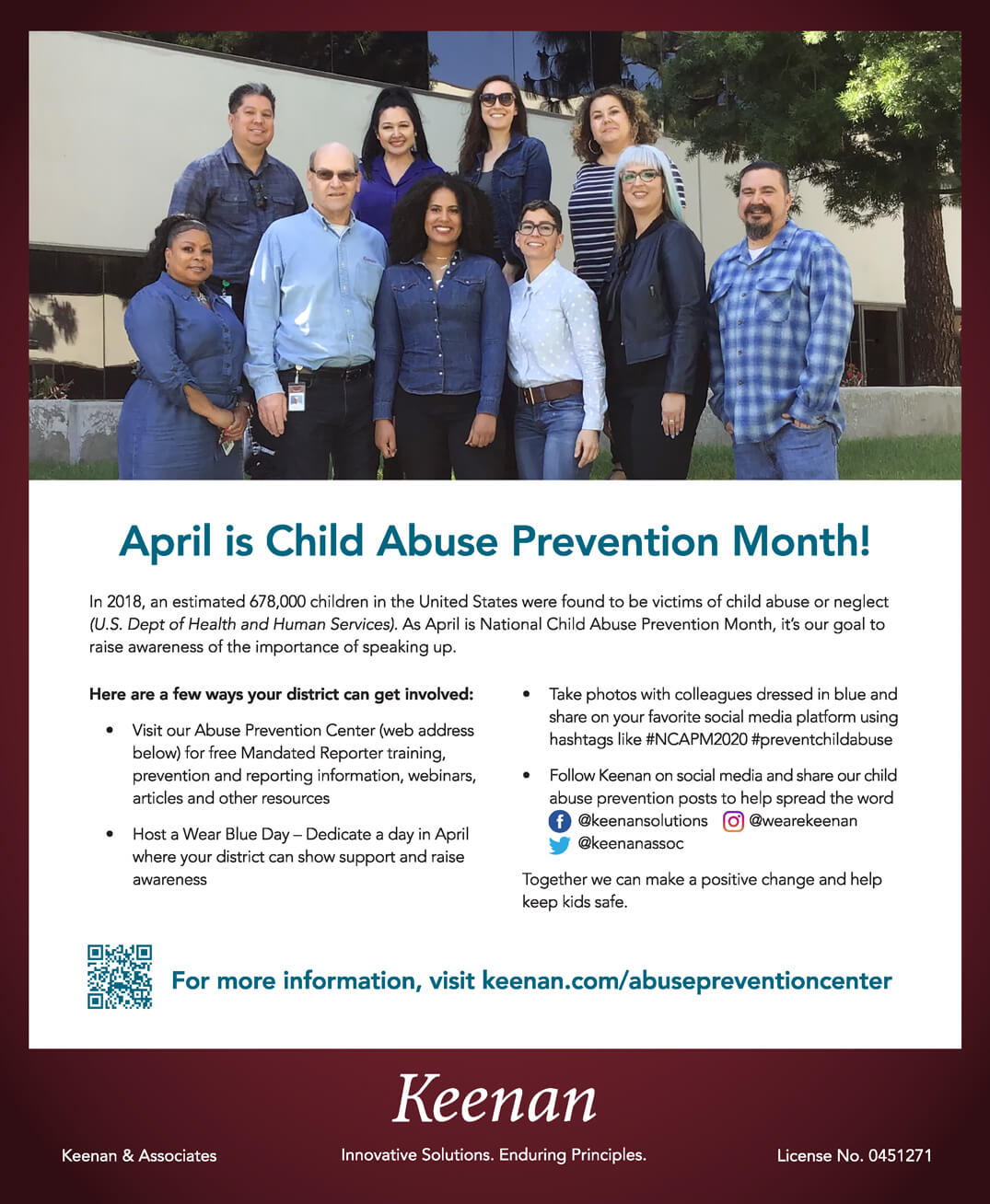
Spring 2020
by the CSBA editorial team
Leaders, researchers advance teacher diversity as an imperative issue
by Andrew Cummins
by Vernon M. Billy
by Bode Owoyele
by Sepideh Yeoh, Teri Vigil and Daryl Camp
by Mike Ambrose
By Scott L. Bailey
Interview with Donn Clickard, CSBA’s Board Member of the Year

n January 2020, CSBA’s Board of Directors was participating in a retreat when one of the directors asked me, “What keeps you up at night?” I chuckled, and then went on to say, “the list is long, but here are a few things…” I then toiled through a laundry list of operational, policy and organizational challenges and opportunities I felt were important for CSBA’s success.
Little did I know that, two short months later, I (along with the rest of the world) would be dealing with a coronavirus (COVID-19) pandemic — something far more serious than any of the items on my to-do list. Nor did I know at the time that this virus would cause many schools across our state to shutter their doors to students for the rest of school year; that school employees would be serving drive-thru meals to students; that almost every school district and county office of education in the state would be scrambling to implement some form of a distance learning program for their entire student body; and that our state (and our nation and world) would be tallying up daily deaths caused by a microscopic bug that has the ability to incapacitate the healthy in a matter of days.
I could never have imagined any of these things. I could never have imagined that I would have to make the very difficult decision to cancel CSBA’s Legislative Action Day for the first time in the history of the association, and that a few short days later — ahead of the Governor’s call to stay at home — I would close CSBA’s office in order to protect my staff and CSBA’s operational capacity from this invisible threat.

Region 1, Del Norte County US
Sherry Crawford
Region 2, Siskiyou COE
A.C. “Tony” Ubalde, Jr.
Region 3, Vallejo City USD
Paige Stauss
Region 4, Roseville Joint Union HSD
Alisa MacAvoy
Region 5, Redwood City ESD
Darrel Woo
Region 6, Sacramento City USD
Yolanda Peña Mendrek
Region 7, Liberty Union HSD
Matthew Balzarini
Region 8, Lammersville Joint USD
Region 9, Atascadero USD
Susan Markarian
Region 10, Pacific Union ESD
Jackie Moran
Region 11, Ventura ESD
William Farris
Region 12, Sierra Sands USD
Meg Cutuli
Region 15, Los Alamitos USD
Karen Gray
Region 16, Silver Valley USD
Debra Schade
Region 17, Solana Beach SD
Wendy Jonathan
Region 18, Desert Sands USD
Region 20, Santa Clara USD
Scott Schmerelson
Region 21, Los Angeles USD
Nancy Smith
Region 22, Palmdale SD
Helen Hall
Region 23, Walnut Valley USD
Donald E. LaPlante
Region 24, Downey USD
Bettye Lusk
Director-at-Large African American,
Monterey Peninsula USD
Crystal Martinez-Alire
Director-at-Large American Indian,
Elk Grove USD
Director-at-Large Asian/Pacific Islander,
Hacienda La Puente USD
Bruce Dennis
Director-at-Large County, Riverside COE
Joaquín Rivera
Director-at-Large Hispanic, Alameda COE
Chris Ungar
NSBA Director, San Luis Coastal USD
Janet Wohlgemuth
CCBE President, Monterey COE
Region 1, Del Norte County US
Sherry Crawford
Region 2, Siskiyou COE
A.C. “Tony” Ubalde, Jr.
Region 3, Vallejo City USD
Paige Stauss
Region 4, Roseville Joint Union HSD
Alisa MacAvoy
Region 5, Redwood City ESD
Darrel Woo
Region 6, Sacramento City USD
Yolanda Peña Mendrek
Region 7, Liberty Union HSD
Matthew Balzarini
Region 8, Lammersville Joint USD
Tami Gunther
Region 9, Atascadero USD
Susan Markarian
Region 10, Pacific Union ESD
Jackie Moran
Region 11, Ventura ESD
William Farris
Region 12, Sierra Sands USD
Meg Cutuli
Region 15, Los Alamitos USD
Karen Gray
Region 16, Silver Valley USD
Debra Schade
Region 17, Solana Beach SD
Wendy Jonathan
Region 18, Desert Sands USD
Albert Gonzalez
Region 20, Santa Clara USD
Scott Schmerelson
Region 21, Los Angeles USD
Nancy Smith
Region 22, Palmdale SD
Helen Hall
Region 23, Walnut Valley USD
Donald E. LaPlante
Region 24, Downey USD
Bettye Lusk
Director-at-Large African American,
Monterey Peninsula USD
Crystal Martinez-Alire
Director-at-Large American Indian,
Elk Grove USD
Gino Kwok
Director-at-Large Asian/Pacific Islander,
Hacienda La Puente USD
Bruce Dennis
Director-at-Large County, Riverside COE
Joaquín Rivera
Director-at-Large Hispanic, Alameda COE
Chris Ungar
NSBA Director, San Luis Coastal USD
Janet Wohlgemuth
CCBE President, Monterey COE

ith the outbreak of COVID-19 in the United States, and the social distancing and other safety-related restrictions being implemented to contain it, schools throughout the country have almost universally switched to distance or virtual learning. The switch has raised countless questions for parents and school leaders alike.
One critical question is around how the confidentiality of student education records will be maintained as required by law, when schools adopt virtual means to educate their students. The U.S. Department of Education, Student Privacy Policy Office (SPPO), has provided some guidance through its “FERPA & Virtual Learning During COVID-19” webinar, in which it answered common questions related to the COVID-19 pandemic, shared best practices on privacy and security, and provided other useful resources.
Most importantly, the webinar is a reminder to school authorities that the Family Educational Rights and Privacy Act (FERPA), the federal privacy law that applies to educational institutions, remains in force even in these unprecedented circumstances. FERPA protects the rights of parents and eligible students to access and seek amendment to student education records, provide consent before personally identifiable information (PII) from a student’s education records may be disclosed to a third party and to file a complaint. The webinar used a number of scenarios to highlight elements of the law, address related questions and communicate important considerations for situations that may arise. Information regarding some of the scenarios are summarized below.

Senior Director of Communications
Troy Flint, tflint@csba.org
Managing Editor
Kimberly Sellery, ksellery@csba.org
Marketing Director
Serina Pruitt, spruitt@csba.org
Staff Writers and Contributors
Andrew Cummins, acummins@csba.org
Alisha Kirby, akirby@csba.org
Graphic Design Manager
Kerry Macklin, kmacklin@csba.org
Senior Graphic Designer
Mauricio Miranda, mmiranda@csba.org
Circulation and Advertising
csba@csba.org
Xilonin Cruz-Gonzalez, Azusa USD
President-elect
Suzanne Kitchens, Pleasant Valley SD
Vice President
Dr. Susan Heredia, Natomas USD
Immediate Past President
Dr. Emma Turner, La Mesa-Spring Valley SD
CEO & Executive Director
Vernon M. Billy
California Schools (ISSN 1081-8936) is published quarterly by the California School Boards Association, Inc., 3251 Beacon Boulevard, West Sacramento, CA 95691, (916) 371-4691. $2 of CSBA membership dues goes toward the subscription to California Schools magazine for each board member and superintendent. The subscription rate for each CSBA nonmember is $20. Periodicals postage paid at West Sacramento, CA and at additional mailing office. Postmaster: Send address changes to California Schools, 3251 Beacon Blvd., West Sacramento, CA 95691.
Articles submitted to California Schools are edited for style, content and space prior to publication. Views expressed are those of the authors and do not necessarily represent CSBA policies or positions. Articles may not be reproduced without written permission of the publisher. Endorsement by CSBA of products and services advertised in California Schools is not implied or expressed.




Dear Boardwise
How do we as a board create a district culture that supports the success of all students?
Sepideh Yeoh: This is a great question. Fostering a district culture that supports success for all students should be a priority for all governance teams. After all, schools exist for the sole purpose of providing a supportive environment where all students can succeed. The governance team has the responsibility to establish and sustain a supportive culture for the district. This culture, however, is not magically created. It takes time, awareness and mindfulness. Furthermore, it begins with each individual member of the governance team.
class act: Best practices in action
class act:
Best practices in action
class act:
Best practices in action
rowing numbers of college scholarships and professional careers. Million-dollar matches broadcast on ESPN. And now, a multitude of high school leagues up and down the state of California. Districts and county offices of education are quickly leveling up their forays into the world of organized esports, or competitions using video games, to engage students in new ways.
Successful and highly popular ventures by early adopters such as the Orange County High School eSports League have led to duplicated efforts in urban, suburban and rural areas. A direct offshoot of the Orange County program can be found in Butte County, which established the Northern California Esports League to much fanfare and community interest. Thirty-eight teams from 25 high schools participated in the Orange County High School eSports League in its 2018 inaugural season, with success leading to the league’s transformation into the North America Scholastic Esports Federation. The federation focuses on helping schools across the country establish their own scholastic leagues and tournaments.
Organizers and education officials say the leagues are about much more than teenagers passing time by lounging around playing video games, but rather, teach leadership, communication, perseverance and determination— many of the same skills gained from participating in other sports and activities.

he following update provides guidance on the Brown Act provisions waived under Gov. Gavin Newsom’s executive orders, and information about the procedures your governing board can use to conduct board meetings during this unique time.
Gov. Newsom has issued multiple executive orders in recent weeks impacting school district and county office of education board meetings. On March 17, 2020, Gov. Newsom issued Executive Order N-29-20. The order superseded paragraph 11 of the previous March 12, 2020, Executive Order N-25-20, which required school districts to provide a physical location from where members of the public could participate in a board meeting.
This overriding Executive Order N-29-20 provides that boards no longer need to make space available for the public to appear at any physical location. Board members and staff may attend regular, special and emergency meetings by telephone or video conference, and members of the public may observe and address the board by telephone or electronic means. The order helps ensure public safety and continued public participation in board meetings while the state’s stay-at-home policy remains in effect.


he statistics are startling. According to the United States Congress Joint Economic Committee, seven in 10 teachers assign homework that requires broadband access, but nearly one in three households don’t have it.
In a December 2018 report, Federal Communications Commission Commissioner Jessica Rosenworcel called this issue, also known as the homework gap, the “cruelest part of the digital divide.” Predictably, the divide further exacerbates achievement gaps that exist among student groups.
The Desert Sands Unified School District Board of Education knew the Riverside County district would have to think creatively inside the box (the box is defined by applicable laws and regulations) to address the issue in a manner that was consistent with its core values and vision to successfully prepare every student for college, career and life. Under the direction of the board, and its commitment to equity, the district developed and deployed an innovative solution to help close the digital divide.

Becoming a trustee in our district seemed a natural transition from my retirement at Atascadero High School. Doing so allowed me to continue to support and serve children. I have been a trustee on the board of the Atascadero Unified School District for 15 years.
Congratulations on being named CSBA’s inaugural Board Member of the Year! What qualities do you think make a good board member?
It was an incredible honor and certainly humbling to be named the first Golden Gavel Award recipient. I believe that outstanding board members will understand that schools belong to the communities they serve. School boards are responsible, among other things, for being responsive to the values, beliefs and priorities of the community. Trustees hire and evaluate the superintendent, set direction, provide support, ensure accountability and provide community leadership as advocates for our children. Trustees do this as a team, not individuals.
What do you see as the role of public education?
The role of public education is reflected in the vision and mission statement of our district. The vision of Atascadero Unified is to ensure students will be college, career and citizenship ready, through talent and teamwork. Our mission statement says that we are dedicated to student success, staff collaboration, community partnership and that we are committed to excellence.
The Lighthouse Atascadero program demonstrates the commitment of our community to work together to combat substance abuse. Lighthouse Atascadero is dedicated to overcoming addiction in our youth through awareness, prevention, intervention and education. It is a cooperative program of the Greyhound Foundation and Atascadero USD. There are currently nine Lighthouse Atascadero programs, which include counseling, mentoring, a student-run business and a community resource library that offers books, articles and other forms of communication to assist students and their families to combat drug and alcohol addiction. Lighthouse Atascadero committee members are available to consult with citizens of other communities seeking to create their own Lighthouse.
Adults can inspire without even knowing it is happening. A teacher once said to me, “The person you will become will be determined by two things: the people you hang out with and the books you read.”
It’s very important that all trustees, whether aspiring, new or veteran, develop the skill of very careful listening. Always strive to do what is best for students and staff. And finally, take what you do very seriously, but do not take yourself too seriously.

Becoming a trustee in our district seemed a natural transition from my retirement at Atascadero High School. Doing so allowed me to continue to support and serve children. I have been a trustee on the board of the Atascadero Unified School District for 15 years.
Congratulations on being named CSBA’s inaugural Board Member of the Year! What qualities do you think make a good board member?
It was an incredible honor and certainly humbling to be named the first Golden Gavel Award recipient. I believe that outstanding board members will understand that schools belong to the communities they serve. School boards are responsible, among other things, for being responsive to the values, beliefs and priorities of the community. Trustees hire and evaluate the superintendent, set direction, provide support, ensure accountability and provide community leadership as advocates for our children. Trustees do this as a team, not individuals.
What do you see as the role of public education?
The role of public education is reflected in the vision and mission statement of our district. The vision of Atascadero Unified is to ensure students will be college, career and citizenship ready, through talent and teamwork. Our mission statement says that we are dedicated to student success, staff collaboration, community partnership and that we are committed to excellence.
The Lighthouse Atascadero program demonstrates the commitment of our community to work together to combat substance abuse. Lighthouse Atascadero is dedicated to overcoming addiction in our youth through awareness, prevention, intervention and education. It is a cooperative program of the Greyhound Foundation and Atascadero USD. There are currently nine Lighthouse Atascadero programs, which include counseling, mentoring, a student-run business and a community resource library that offers books, articles and other forms of communication to assist students and their families to combat drug and alcohol addiction. Lighthouse Atascadero committee members are available to consult with citizens of other communities seeking to create their own Lighthouse.
Adults can inspire without even knowing it is happening. A teacher once said to me, “The person you will become will be determined by two things: the people you hang out with and the books you read.”
It’s very important that all trustees, whether aspiring, new or veteran, develop the skill of very careful listening. Always strive to do what is best for students and staff. And finally, take what you do very seriously, but do not take yourself too seriously.
in the time of
coronavirus




With nearly every California school closed due to the coronavirus (COVID-19) pandemic, board members, administrators, teachers and classified employees are grappling with ways to continue educating and supporting the state’s 6.2 million K-12 students. During this difficult and unprecedented time, CSBA is working to serve its members by providing the most up-to-date information and guidance from both the state and federal government, as well as by collecting and sharing resources and examples of what districts are doing to address pressing issues such as distance learning, student well-being and meal distribution.
|
60.9% are low-income students |
16% had no internet connection at home in 2017 |
27% did not have broadband access in 2017 |
800,000 students receive special education services |
19.3% of students are English learners |
in the time of
coronavirus



|
60.9% are low-income students |
16% had no internet connection at home in 2017 |
27% did not have broadband access in 2017 |
800,000 students receive special education services |
19.3% of students are English learners |
are low-income students
had no internet connection at home in 2017
did not have broadband access in 2017
students receive special education services
of students are English learners








 y seventh grade, Zachary Nimmo had meticulously mapped out his future to the tiniest detail — take every engineering course offered at Amador Valley High School in Pleasanton, attend Las Positas Community College for two years, transfer to Cal Poly to earn an engineering degree, then move to Seattle. His friends called him a hybrid — an excellent soccer and lacrosse athlete and a self-proclaimed geek — passionate about computers, coding and comic books. But something started to change in eighth grade, and his parents were concerned with his darkening behavior.
y seventh grade, Zachary Nimmo had meticulously mapped out his future to the tiniest detail — take every engineering course offered at Amador Valley High School in Pleasanton, attend Las Positas Community College for two years, transfer to Cal Poly to earn an engineering degree, then move to Seattle. His friends called him a hybrid — an excellent soccer and lacrosse athlete and a self-proclaimed geek — passionate about computers, coding and comic books. But something started to change in eighth grade, and his parents were concerned with his darkening behavior.
“Our first signal was isolation. He was seeing friends less frequently, then no longer wanted to play sports, and spent more time alone in his room,” said his father, Steve Nimmo. “We took him to his pediatrician and Zachary was diagnosed with severe anxiety.” Zachary’s parents and doctors immediately took steps to help him, but, tragically, on Oct. 26, 2018, just two months into his freshman year in high school, Zachary Nimmo took his own life. He was 14.



 y seventh grade, Zachary Nimmo had meticulously mapped out his future to the tiniest detail — take every engineering course offered at Amador Valley High School in Pleasanton, attend Las Positas Community College for two years, transfer to Cal Poly to earn an engineering degree, then move to Seattle. His friends called him a hybrid — an excellent soccer and lacrosse athlete and a self-proclaimed geek — passionate about computers, coding and comic books. But something started to change in eighth grade, and his parents were concerned with his darkening behavior.
y seventh grade, Zachary Nimmo had meticulously mapped out his future to the tiniest detail — take every engineering course offered at Amador Valley High School in Pleasanton, attend Las Positas Community College for two years, transfer to Cal Poly to earn an engineering degree, then move to Seattle. His friends called him a hybrid — an excellent soccer and lacrosse athlete and a self-proclaimed geek — passionate about computers, coding and comic books. But something started to change in eighth grade, and his parents were concerned with his darkening behavior.
“Our first signal was isolation. He was seeing friends less frequently, then no longer wanted to play sports, and spent more time alone in his room,” said his father, Steve Nimmo. “We took him to his pediatrician and Zachary was diagnosed with severe anxiety.” Zachary’s parents and doctors immediately took steps to help him, but, tragically, on Oct. 26, 2018, just two months into his freshman year in high school, Zachary Nimmo took his own life. He was 14.


If so, the CSBA Golden Bell Awards program wants to hear from you.
Help shine a light on outstanding achievement in districts and county offices of education throughout California and the school boards that have made such success possible.

ohn Burton Advocates for Youth, named for the former member of the California State Assembly and President Pro Tem of the State Senate, works to improve the quality of life for California’s foster, former foster and homeless youth through three areas: housing, health and education.
California Schools recently talked with Raucher about the barriers these children face in transitioning to higher education, the role K-12 schools play in preparing students for success and the need for systems to share information about foster youth.
Congratulations
The following graduates have successfully completed the program, gaining essential knowledge for being an effective governance team member.
Ammie Hines
Christina Bentz
Alhambra USD
Wing Ho
Bear Valley USD
Susan Smartt
Gail Lyons
Calexico USD
Enrique Alvarado
Chester Jeng
Lauren Klatzker
Hughes-Elizabeth Lakes Union SD
Hugo Estrada
Lola Skelton
Lori Slaven
Melanie Dohn
Nicoleta Trifa
Wise Nadjib
Huntington Beach Union HSD
Diana Carey
Ashley Anderson
Michelle Barto
Norwalk-La Mirada USD
Jorge Tirado
Paramount USD
Carmen Gomez
Pleasant Valley SD
Suzanne Kitchens

































